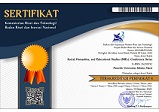Pengaruh Model Auditory Intellectually Repetition berbasis Metode Ekstempooran terhadap Keterampilan Berbicara Siswa Sekolah Dasar
Abstract
Keterampilan berbicara mahasiswa perlu mendapatkan perhatian yang serius karena dinilai masih rendah. Tujuan dari penelitian ini yaitu untuk mengetahui pengaruh model AIR berbasis metode ekstemporan terhadap keterampilan berbicara mahasiswa. Metode yang digunakan yaitu kuantitatif dengan jenis preeksperimen desain one group pretest postes. Sampel yang digunakan yaitu kelas V yang berjumlah 30 orang dengan teknik purposive sampling. Instrumen yang digunakan yaitu instrument tes bentuk lisan yang merujuk pada lima indicator yakni intonasi, pelafalan, mimic, kosakata, dan kelancaran. Keempat indicator tersebut dinilai menggunakan rubrik penilaian yan diuji validitas isi oleh ahli dan data diolah dengan menggunakan teknis analisis data deskriptif dan analisis data inferensial. Hasil penelitian menunjukan berdasarkan perhitungan uji t diperoleh nilai sig. sebesar 0,001 pada taraf signifikan 𝛼 = 0,05 sehingga sig. < 𝛼 yang berarti Ho ditolak. Demikian berdasarkan hasil uji hipotesis dapat ditarik kesimpulan bahwa terdapat pengaruh model AIR berbasis metode ekstemporan terhadap keterampilan berbicara siswa sekolah dasar. Demikian metode AIR berbasis metode ekstemporan bisa menjadi salah satu alternatif solusi untuk meningkatkan keterampilan berbicara siswa untuk menstimulus dan meningkatkan penguasaan kosakata siswa dalam mengungkapkan ide atau gagasan ke dalam bunyi Bahasa.
Keywords
Full Text:
PDFReferences
Ariska, M., Fuaddunazmi, M., & Habibi, H. (2016). Pengaruh Pendekatan Pembelajaran Air (Auditory Intellectually Repetition) Dengan Metodedemonstrasi Terhadap Kemampuan Berkomunikasi Dan Kemampuan Berpikir Kritis Siswa. Lensa: Jurnal Kependidikan Fisika, 4(2), 62–65.
Asyari, L., Nuriyanti, R., Gunawan, D., & Adiredja, R. K. (2021). The Influence of Experiential Learning Model on Primary School Student’s Creative Thinking Skills. Social, Humanities, and Educational Studies (SHEs): Conference Series, 4(1), 70–76.
Aufa, F. N., Purbasari, I., & Widianto, E. (2020). Keterampilan Berbicara Siswa Sekolah Dasar Menggunakan Visualisasi Poster Sederhana. WASIS: Jurnal Ilmiah Pendidikan, 1(2), 86–92.
Bonatua, D. S., Mulyono, D., & Febriandi, R. (2021). Penerapan Model Pembelajaran AIR (Auditory, Intellectualy, Repetition) menggunakan Media Gambar pada Pembelajaran Tematik Sekolah Dasar. Jurnal Basicedu, 5(5), 3850–3857. https://doi.org/10.31004/basicedu.v5i5.1462
Fatimah, F. N. (2021). EFEKTIVITAS PENGGUNAAN METODE EKSPEMPORAN TERHADAP PENINGKATAN KEMAMPUAN BERBICARA MAHASISWA DI DEPAN PUBLIK (Quasi Eskperimen pada Mahasiswa STAI Al-Azhary Cianjur).
Febianto, D., & Nopita, R. (2024). Halaman 401-409 Volume 2 Nomor 2 Tahun. Indonesian Journal of Innovation Multidisipliner Research, 401.
Febriyanto, B. (2019). JURNAL CAKRAWALA PENDAS METODE CERITA BERANTAI UNTUK MENINGKATKAN KETERAMPILAN BERBICARA SISWA PADA PEMBELAJARAN BAHASA INDONESIA. Jurnal Cakrawala Pendas, 5(2), 158.
Hamsia, W. (2018). DEVELOPING STUDENTS’SPEAKING ABILITY THROUGH STORY COMPLETION. Jo-ELT (Journal of English Language Teaching), 5(1), 57–64.
Harahap, F. K. S., Ulkhaira, N., Puspitasari, P., & Nasution, J. S. (2024). Hakikat Keterampilan Berbicara pada Siswa Sekolah Dasar Kelas Tinggi. EDU SOCIETY: JURNAL PENDIDIKAN, ILMU SOSIAL DAN PENGABDIAN KEPADA MASYARAKAT, 4(1), 1278–1283.
Hardiansyah, F. (2024). THE EFFECT OF AUDITORY INTELLECTUALLY AND REPETITION LEARNING MODEL ON STUDENTS’CRITICAL THINKING ABILITIES IN ELEMENTARY SCHOOLS. Fundamental Journal of Elementary Education, 1(2), 5–10.
Hidayati, N. A., & Darmuki, A. (2021a). Penerapan Model Auditory Intellectually Repetition (AIR) untuk Meningkatkan Kemampuan Berbicara Pada Mahasiswa. Jurnal Educatio FKIP UNMA, 7(1), 252–259. https://doi.org/10.31949/educatio.v7i1.959
Hidayati, N. A., & Darmuki, A. (2021b). Penerapan Model Auditory Intellectually Repetition (AIR) untuk Meningkatkan Kemampuan Berbicara Pada Mahasiswa. Jurnal Educatio FKIP UNMA, 7(1), 252–259. https://doi.org/10.31949/educatio.v7i1.959
Hilaliyah, T. (2017). Tes Keterampilan Berbicara Siswa Dalam Pembelajaran. Jurnal Membaca Bahasa Dan Sastra Indonesia, 2(1), 83–98.
Khoyimah, N., & Santoso, I. (2020). Improving students speaking ability through repetition drill. PROJECT (Professional Journal of English Education), 3(1), 26–35.
Lase, Y., & Zagoto, A. (2024). ANALISIS KESALAHAN PELAFALAN KATA DALAM PROSES PEMBELAJARAN BAHASA INDONESIA OLEH SISWA KELAS VIII-A DI SMP NEGERI 1 IDANOTAE. https://jurnal.uniraya.ac.id/index.php/FAGURU
Lumettu, A., & Runtuwene, T. L. (2018). Developing the Students’ English Speaking Ability Through Impromptu Speaking Method. Journal of Physics: Conference Series, 953(1), 012035.
Nainggolan, R., Amelia Ningsih, P., & Alamanda, A. (2024). Development Of Students’Speaking Skills Based on The Extra-Temporal Method in Indonesia Language Subject. Extratemporaneous Methods in Indonesian Subjects ETJ (Educational Technology Journal) |, 4(2), 36–42. https://journal.unesa.ac.id/index.php/etj
Nirwana, S. P., Irianto, A., & Rachmadtullah, R. (2023). Model Pembelajaran Auditory, Intellectually, Repetition (AIR) terhadap Keterampilan Berkomunikasi pada Muatan Ilmu Pengetahuan Sosial di Sekolah Dasar. EduBase: Journal of Basic Education, 4(2), 182–188.
Nuriyanti, R., Muslihah, N. N., Susilawati, S., & Mutiara, L. (2025). Pengaruh Model RADEC Berbantuan Metode Student Question Have Terhadap Kemampuan Membaca Pemahaman Siswa SD. Kalam Cendekia: Jurnal Ilmiah Kependidikan, 13(2).
Ramadani, S. A., Puspitasari, A., & Muin, N. (2024). Peningkatan Keterampilan Berbicara Dengan Menggunakan Model Auditory Intellectually Repetition. In Jambura Journal of Community Empowerment (JJCE) (Vol. 5, Issue 5).
Sabila, A. (2015). Kemampuan Berpidato Dengan Metode Ekstemporan. Jurnal Pesona, 1(1).
Selfiyanti, B., Setiawan, F., & Mirnawati, L. B. (2022). Peningkatan Literasi Berbicara Menggunakan Media Gambar Berseri pada Siswa Kelas II SD. Jurnal Pendidikan Tambusai, 6(1), 59–68.
Sudarman, S., & Mangunsong, R. R. D. (2022). The Affect The Effect Of Motoric, Sensoric And Cognitive On Speaking Ability Of Intellectual Disability Children. Jurnal Keterapian Fisik, 27–34.
Suryani, N., Jailani, Ms., Suriani, N., Raden Mattaher Jambi, R., & Sulthan Thaha Saifuddin Jambi, U. (2023). Konsep Populasi dan Sampling Serta Pemilihan Partisipan Ditinjau Dari Penelitian Ilmiah Pendidikan. http://ejournal.yayasanpendidikandzurriyatulquran.id/index.php/ihsan
Tabelessy, N. (2015). KETERAMPILAN BERBICARA BERBASIS METODE EKSTEMPORAN BAGI SISWA SMP.
Tarigan, Y. H. B., Cipta, N. H., & Rokmanah, S. (2023). Pentingnya Keterampilan Berbahasa Indonesia Pada Kegiatan Pemebelajaran Sekolah Dasar. Didaktik: Jurnal Ilmiah PGSD STKIP Subang, 9(5), 829–842.
Tias, H. K., & Fikrati, A. N. (2017). Implementasi Cooperative LearningType Auditory Intellectually RepetitionUntuk Meningkatkan Kemampuan Komunikasi SiswaMI Al. JOURNAL PROCEEDING, 3(1).
Ulva, M., Indah Resti Ayui Suri, dan, Letnam Kolonel Endro Suratmin, J. H., & Bandar Lampung, K. (2019). Pengaruh Model Pembelajaran Auditory Intellectualy Repetition Terhadap Kemampuan Komunikasi Matematis Peserta Didik. In Jurnal Pendidikan Matematika (Vol. 7, Issue 1).
Wahono, S. S., & Zahro, I. H. N. (2021). Using Inquiry Based Learning to Improve Students Speaking Skills. Journal of Language Intelligence and Culture, 3(2), 125–138.
Xue, Y. (2023). A Study on the Influence of Mother Tongue Transfer on English Pronunciation of Primary Students. Creative Education, 14(11), 2123–2130.
Yalçınkaya, F., Muluk, N. B., & Şahin, S. (2009). Effects of listening ability on speaking, writing and reading skills of children who were suspected of auditory processing difficulty. International Journal of Pediatric Otorhinolaryngology, 73(8), 1137–1142.
Refbacks
- There are currently no refbacks.





